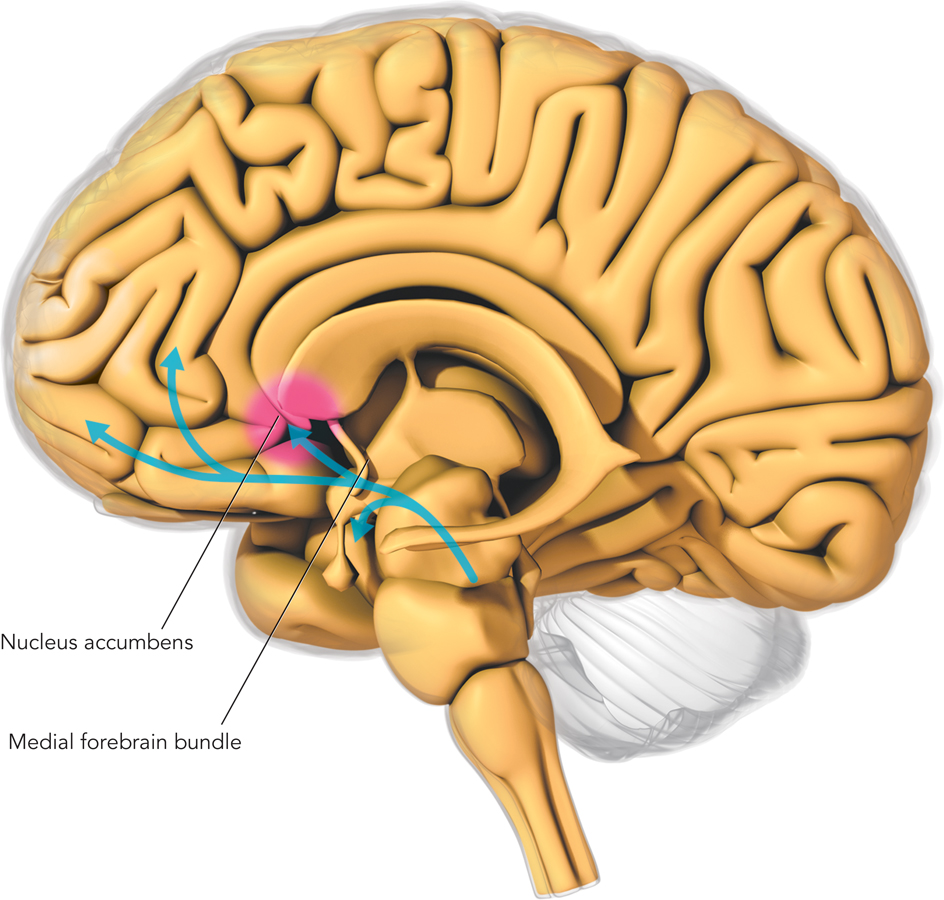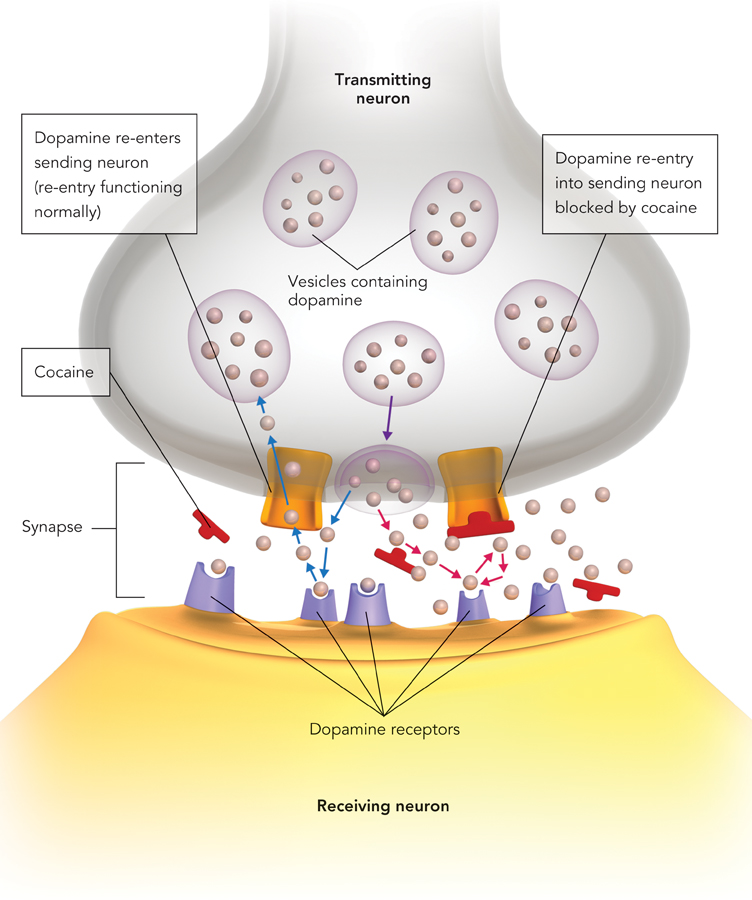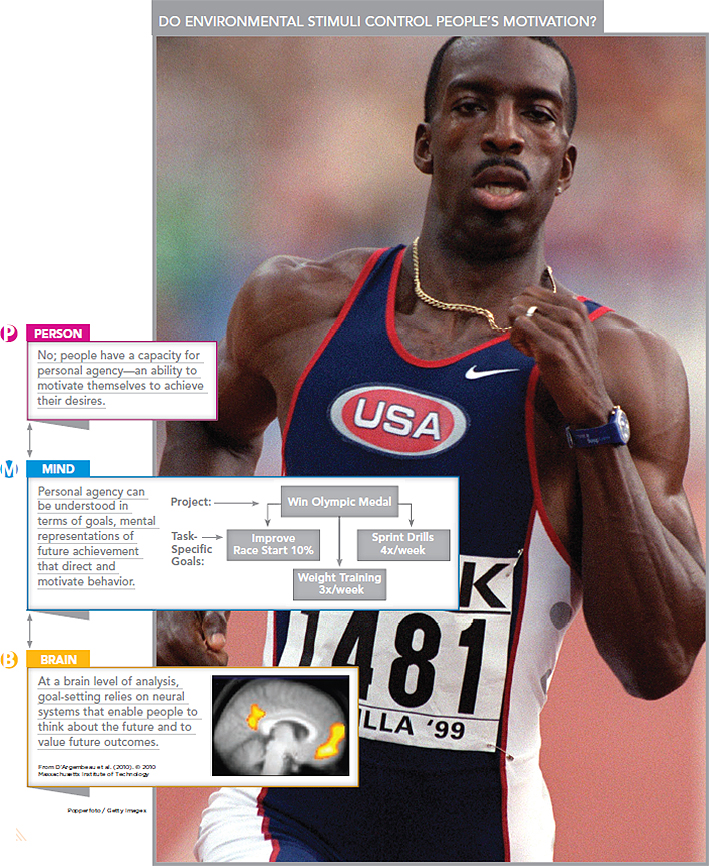11.7 Motivation and the Brain
Let’s conclude our coverage of motivation by moving down a level of analysis. We’ve just seen how mental contents—
Approach, Avoidance, and the Brain
Preview Question
Question
 What are the biological bases of approach and avoidance motivation?
What are the biological bases of approach and avoidance motivation?
We’ve said throughout this chapter that motivational forces are diverse. Yet there is a simple distinction—
Approach motivation refers to a broad class of motives that concern the growth and enhancement of an organism (Harmon-
The approach/avoidance distinction is psychological; it claims that approach and avoidance are psychologically distinct states. Are they also biologically distinct? In other words, are there distinct systems in the brain that correspond to these distinct types of motivation?
Much theory and research suggests that there are. A theoretical framework developed by British scientist Jeffrey Gray (reviewed in Smillie, Pickering, & Jackson, 2006) is useful for thinking about motivation and the brain. Gray conducted research on animals. In laboratory studies, they were exposed to stimuli that signaled the later occurrence of either rewards (which the animal would be inclined to approach) or punishments (which the animal would want to avoid). Gray then explored the brain systems when the two types of signals were presented. Based on this research, he distinguished between a behavioral approach system and a behavioral inhibition system. Both systems can be understood in terms of two types of biological mechanisms—
BEHAVIORAL APPROACH SYSTEM. Stimuli that signal the future presence of rewards activate a behavioral approach system. The behavioral approach system is a neural system that arouses an organism, energizing it to seek out rewarding stimuli (e.g., food).
The neurotransmittiter dopamine is the biochemical key to this reward system. Although there is some disagreement on its precise functions, dopamine is known to be released when an organism encounters reward signals, and to activate brain regions needed for pursuing those rewards (Pickering & Corr, 2008).
Regarding the anatomy of this system—

BEHAVIORAL INHIBITION SYSTEM. Signals of punishment activate a behavioral inhibition system. The behavioral inhibition system is a neural system within the brain that increases levels of arousal and feelings of anxiety. Activation of this system causes organisms to stop pursuing rewards and to attend, instead, to environmental threats. The behavioral inhibition system is activated by stimuli that signal punishment, by novel stimuli that could be threatening, and by stimuli that innately trigger fear.
Both the biochemistry and the anatomy of the behavioral inhibition system differ from those of the approach system. In terms of the biochemistry, the most important neurotransmitter is not dopamine but serotonin (Graeff, 2004). Anatomically, the key neural systems are located in the hippocampus and the amygdala (Barrós-
The biological differences between the systems are consistent with the psychological distinctions you learned earlier. Time and again, psychologists proposed that motives to attain positive outcomes and to avoid harms and threats were psychologically distinct. Brain research reveals that they are distinct biologically, too.
Brain research with humans provides further evidence of these distinctions, while also widening the scope of brain mechanisms involved. In addition to the lower-
WHAT DO YOU KNOW?…
Question 21
Indicate whether each of the following items is associated with (i) the behavioral approach system or (ii) the behavioral inhibition system.
Serotonin
A. B. Brain stem and limbic system
A. B. Activated by punishment
A. B. Hippocampus and amygdala
A. B. Right hemisphere
A. B. Dopamine
A. B. Activated by potential rewards
A. B. Left hemisphere
A. B.
Addiction and the Brain
Preview Question
Question
 What is the biological basis of addiction?
What is the biological basis of addiction?
Sometimes people are too motivated. They incessantly seek out substances or behaviors that are attractive, but ultimately harmful. These are people who suffer from addictions. Addictions are psychological disorders in which people use a drug or engage in an activity repeatedly and uncontrollably (Goldman, Oroszi, & Ducci, 2005).
Addictions are costly to individuals and to society as a whole. At a personal level, substance abuse can ruin friendships, romantic relationships, and family life. In economic terms, the cost of addictions is staggering: an estimated $600 billion a year in the United States in health-
Why are so many people so prone to develop addictions? Addictive substances tap into a neural system found in everyone’s brain: the reward system (behavioral approach system) described in the preceding section. A wide variety of addictive substances activate the brain circuitry that normally becomes active during rewarding, pleasurable experiences (Wise, 1998).
Addictive substances affect the reward system by increasing dopamine activity. Different substances increase dopamine in different ways. For example, nicotine increases the amount of dopamine released into the spaces between neurons (Stahl, 2002). Cocaine blocks a molecular process in which previously released dopamine is taken back into brain cells (Nestler, 2006; Figure 11.11). Either way, activity in the reward center of the brain increases.

Furthermore, addictive substances create two long-
Evidence indicates that the addictive behaviors have an effect on the brain that is similar to that of addictive substances. For instance, gambling—
WHAT DO YOU KNOW?…
Question 22
Addictive substances activate the behavioral approach system, also known as the system. Nicotine affects this system by the amount of dopamine released into the space between neurons, whereas blocks dopamine from being taken back up into the cell. Gambling has been shown to activate the same center as addictive substances.
Goals and the Brain
Preview Question
Question
 What brain regions are active during goal processing?
What brain regions are active during goal processing?
Goals shape motivation. This simple sentence captures a main theme of research on motivation and the mind. Research on motivation and the brain is beginning to shed light on the biological mechanisms that make it possible for people to formulate personal goals.
Psychologically, goals have two key features: (1) thoughts about the future and (2) thoughts that a person cares about. Goals, then, are not simple statements of fact (e.g., “Someday my hair will be gray”). They represent future states that one values (e.g., “Someday I will earn a college degree”). Because goals have more than one aspect psychologically, you might expect that more than one brain region will be involved in goal processing.
To study the neural basis of people’s thoughts about goals, researchers (D’Argembeau et al., 2010) first asked participants to think of some future possibilities that were personal goals for them, and some other possible future events that they might experience but that were not personal goals. Later, they used a brain scanner to create images of regions of the brain that were highly active while participants were thinking about their personal goals, future activities that were not personal goals, and also some routine activities such as taking a shower.
Consistent with what one would expect from a psychological analysis of goals, two different brain regions—



WHAT DO YOU KNOW?…
Question 23
Brain-